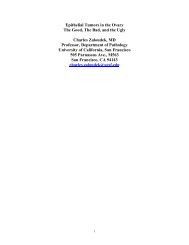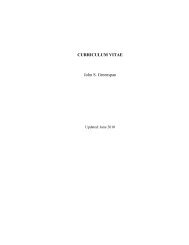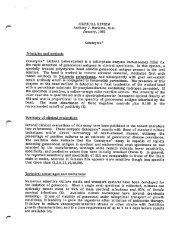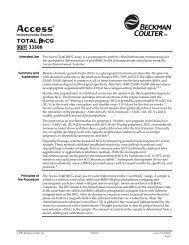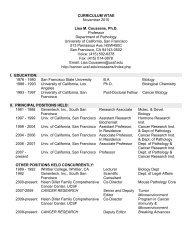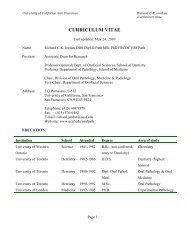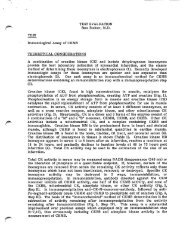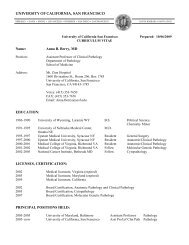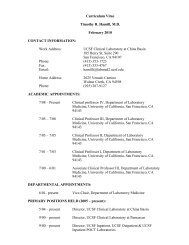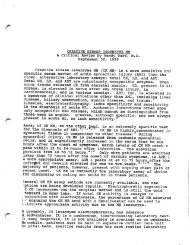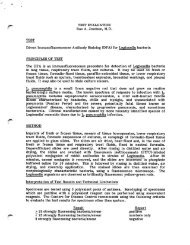Lobular Breast Cancer: Common Problems in Diagnosing LCIS in ...
Lobular Breast Cancer: Common Problems in Diagnosing LCIS in ...
Lobular Breast Cancer: Common Problems in Diagnosing LCIS in ...
You also want an ePaper? Increase the reach of your titles
YUMPU automatically turns print PDFs into web optimized ePapers that Google loves.
<strong>Lobular</strong> <strong>Breast</strong> <strong>Cancer</strong>:<br />
<strong>Common</strong> <strong>Problems</strong> <strong>in</strong> Diagnos<strong>in</strong>g <strong>LCIS</strong> <strong>in</strong> Core Needle Biopsies<br />
Joseph Rabban MD MPH<br />
Associate Professor<br />
UCSF Pathology Department<br />
joseph.rabban@ucsf.edu<br />
June 2010<br />
Introduction:<br />
<strong>Lobular</strong> breast cancer can present an array of pathologic diagnostic challenges and pitfalls that are dist<strong>in</strong>ct<br />
from those encountered <strong>in</strong> tumors of ductal differentiation. Recognition of lobular carc<strong>in</strong>oma <strong>in</strong> situ (<strong>LCIS</strong>)<br />
and dist<strong>in</strong>ction from DCIS is particularly important because of unique management implications and<br />
problems <strong>in</strong> differential diagnosis. These issues are most significant <strong>in</strong> core needle biopsy evaluation and <strong>in</strong><br />
non-<strong>in</strong>vasive tumors (<strong>LCIS</strong>). Therefore this lecture emphasizes practical issues <strong>in</strong> <strong>LCIS</strong> encountered <strong>in</strong> core<br />
biopsies.<br />
Outl<strong>in</strong>e of Lecture:<br />
Def<strong>in</strong>ition of lobular differentiation<br />
Morphology<br />
Immunohistochemistry<br />
Features of <strong>LCIS</strong> <strong>in</strong> core biopsies associated with higher risk for unsampled <strong>in</strong>vasive cancer<br />
<strong>LCIS</strong> with necrosis<br />
Pleomorphic <strong>LCIS</strong><br />
Variants of <strong>LCIS</strong> that mimic DCIS<br />
Florid <strong>LCIS</strong><br />
<strong>LCIS</strong> with necrosis<br />
<strong>LCIS</strong> <strong>in</strong> collagenous spherulosis<br />
Pleomorphic <strong>LCIS</strong><br />
Variants of <strong>LCIS</strong> that mimic <strong>in</strong>vasive cancer<br />
<strong>LCIS</strong> <strong>in</strong> scleros<strong>in</strong>g adenosis<br />
Variants of <strong>LCIS</strong> that may go undetected<br />
<strong>LCIS</strong> <strong>in</strong> papilloma<br />
<strong>LCIS</strong> <strong>in</strong> fibroadenoma<br />
<strong>LCIS</strong> <strong>in</strong> atrophic breast<br />
Cl<strong>in</strong>ical significance of <strong>LCIS</strong> <strong>in</strong> core needle biopsies<br />
Def<strong>in</strong>ition of <strong>Lobular</strong> Differentiation<br />
There are several ways to def<strong>in</strong>e lobular differentiation of breast cancer: morphology (the traditional<br />
method); immunohistochemical (loss of E-cadher<strong>in</strong> immunoexpression and mislocalization of p120); or<br />
molecular (mutation <strong>in</strong> E-cadher<strong>in</strong> gene 16q22.1). S<strong>in</strong>ce the latter is not practical <strong>in</strong> daily cases, the first two<br />
options rema<strong>in</strong>. Most pathologists have probably encountered cases <strong>in</strong> which there is discrepancy between<br />
the morphology and immunohistochemistry. Recent studies suggest that the def<strong>in</strong>ition of E-cadher<strong>in</strong><br />
immunophenotype probably is not as simple as “lack of sta<strong>in</strong><strong>in</strong>g”; <strong>in</strong>stead, occasional cases with morphologic<br />
and molecular criteria for lobular differentiation have been found to show variable degrees/patterns of Ecadher<strong>in</strong><br />
expression (discussed below). In short, while it may be valid to equate “loss of E-cadher<strong>in</strong> sta<strong>in</strong><strong>in</strong>g”<br />
with lobular differentiation, it is not necessarily valid to exclude lobular differentiation <strong>in</strong> morphologically<br />
“lobular” tumors just because of positive E-cadher<strong>in</strong> sta<strong>in</strong><strong>in</strong>g. Thus, morphology is essential <strong>in</strong> def<strong>in</strong><strong>in</strong>g<br />
lobular breast tumors. There are several morphologic variations of lobular breast cancer, particularly with<br />
respect to <strong>in</strong> situ tumors:
Key morphologic features of classic <strong>LCIS</strong>:<br />
Morphologic variations of <strong>LCIS</strong>:<br />
Classic <strong>LCIS</strong><br />
-classic lobulocentric pattern<br />
-florid pattern<br />
-ductocentric pattern<br />
-with necrosis<br />
-with Pagetoid spread<br />
-<strong>in</strong>volv<strong>in</strong>g collagenous spherulosis<br />
Pleomorphic <strong>LCIS</strong><br />
Architecture:<br />
Low magnification:<br />
Lobulocentric (ac<strong>in</strong>ar) growth = clusters of distended ac<strong>in</strong>i (grape cluster-like)<br />
Ductocentric florid growth = solid expansion of larger ducts<br />
Ductocentric m<strong>in</strong>imal growth = bulbous outpouch<strong>in</strong>gs from duct (clover leaf-like)<br />
Higher magnification:<br />
Loss of cell-cell cohesion<br />
Loss of polarity at the periphery<br />
Lack of glandular/ac<strong>in</strong>ar formation<br />
Cytology:<br />
Round/polygonal cells<br />
Round nuclei<br />
Intracytoplasmic vacuoles / signet r<strong>in</strong>g formation (mucicarm<strong>in</strong>e positive*)<br />
+/- targetoid dot-like material <strong>in</strong> vacuole<br />
*normal ductal epithelium should not conta<strong>in</strong> mucicarm<strong>in</strong>e positive cytoplasm<br />
Note: Two variations of non-pleomorphic <strong>LCIS</strong> were described by Haagensen, <strong>Cancer</strong> 1978:<br />
Type A (classic type) = smaller cells, scant cytoplasm, round nuclei, t<strong>in</strong>y or absent nuclei.<br />
Type B (large cell type) = more cytoplasm, larger nuclei, more variable size/shape, nucleoli.<br />
Currently we do not report the Haagensen sub-type of <strong>LCIS</strong> but it is important to recognize that the nuclear changes<br />
of Type B <strong>LCIS</strong> should not be classified as pleomorphic <strong>LCIS</strong> (see below)<br />
Key morphologic features of pleomorphic <strong>LCIS</strong>:<br />
Architecture:<br />
Same as for classic <strong>LCIS</strong>; common to have central necrosis<br />
Mimics high grade DCIS<br />
Cytology:<br />
Large polygonal cells<br />
May have apocr<strong>in</strong>e cytoplasm<br />
Nuclear size 4X lymphocyte nuclei<br />
Moderate to severe nuclear atypia<br />
Potential Pitfall: Pleomorphic <strong>LCIS</strong> has more severe nuclear atypia and nuclear size <strong>in</strong>crease than<br />
Type B <strong>LCIS</strong>. The latter should not be overdiagnosed as pleomorphic <strong>LCIS</strong>.<br />
Dist<strong>in</strong>ction of ALH from <strong>LCIS</strong>: There is evidence of different risks for develop<strong>in</strong>g cancer between ALH<br />
(relative risk of about 4) and <strong>LCIS</strong> (relative risk rang<strong>in</strong>g from 4 to 12) and therefore, when possible, the<br />
diagnostic dist<strong>in</strong>ction should be made (based on literature summarized by Rosen PP. “<strong>LCIS</strong> and ALH” <strong>in</strong> <strong>Breast</strong> Pathology, 3 rd<br />
ed; LWW, 2009). However, there are no universally accepted criteria. Criteria by Page and Simpson and<br />
criteria by Rosen focus on the proportion of ac<strong>in</strong>i <strong>in</strong> a term<strong>in</strong>al duct lobular unit (TDLU) that are expanded<br />
(distended) by the tumor cells. Page and Simpson def<strong>in</strong>e full distention of a s<strong>in</strong>gle ac<strong>in</strong>us as 8 or more cells<br />
across the diameter, though this criteria may not be fulfilled <strong>in</strong> many cases that most pathologists would<br />
otherwise call <strong>LCIS</strong>. Pagetoid extension <strong>in</strong>to the term<strong>in</strong>al ducts can be seen <strong>in</strong> either ALH or <strong>LCIS</strong>.
<strong>LCIS</strong>: Half or more of the ac<strong>in</strong>i are fully distended by tumor cells only.<br />
ALH: Less than half of the ac<strong>in</strong>i are distended by tumor cells.<br />
In some cases the f<strong>in</strong>d<strong>in</strong>gs fall at the border between the two and the classification is up to the pathologist’s<br />
judgment. Clearly this will result <strong>in</strong> some observer variation <strong>in</strong> such borderl<strong>in</strong>e cases. In reaction to this,<br />
some authors have proposed lump<strong>in</strong>g any non-<strong>in</strong>vasive atypical lobular entity <strong>in</strong>to a category of “lobular<br />
neoplasia”. Rosen strongly advises avoid<strong>in</strong>g this approach because 1.) it does not allow for recognition of<br />
clear cut cases with cl<strong>in</strong>ical significance, such as <strong>LCIS</strong> with necrosis or pleomorphic <strong>LCIS</strong>, that is much<br />
different from m<strong>in</strong>imal ALH and because 2.) most cases can be separated <strong>in</strong>to conventional categories<br />
whereas only rare cases sit at the border.<br />
Immunophenotype of <strong>LCIS</strong>:<br />
E-cadher<strong>in</strong>: Most cases of lobular carc<strong>in</strong>oma (<strong>in</strong> situ or <strong>in</strong>vasive) lack E-cadher<strong>in</strong> immunoexpression,<br />
which is otherwise present <strong>in</strong> a membranous pattern <strong>in</strong> lum<strong>in</strong>al epithelium (regardless of benign or<br />
malignant) and <strong>in</strong> myoepithelium. This immunophenotype results from E-cadher<strong>in</strong> gene mutation (16q22.1),<br />
found <strong>in</strong> most lobular cancers (Berx et al. EMBO J 1995; 14: 6107 and Berx et al. Oncogene 1996; 13: 1919). The Ecadher<strong>in</strong><br />
prote<strong>in</strong> is normally located at the cell membrane and has an extracellular doma<strong>in</strong>, an<br />
<strong>in</strong>tramembranous doma<strong>in</strong> and an <strong>in</strong>tracytoplasmic doma<strong>in</strong>. The function is to ma<strong>in</strong>ta<strong>in</strong> cell to cell adhesion.<br />
The E-cadher<strong>in</strong> complex also <strong>in</strong>volves caten<strong>in</strong>s (alpha, beta, gamma and p120 caten<strong>in</strong>s). Loss of the Ecadher<strong>in</strong><br />
prote<strong>in</strong> via gene mutation leads to loss of cell to cell cohesion, result<strong>in</strong>g <strong>in</strong> the morphology of lobular<br />
cancer.<br />
Interpretation of E-cadher<strong>in</strong> is straightforward <strong>in</strong> most cases: there is complete loss of expression <strong>in</strong><br />
ALH/<strong>LCIS</strong>/<strong>in</strong>vasive lobular carc<strong>in</strong>oma. However, recently it has been demonstrated that some cases with<br />
true molecular defects <strong>in</strong> the E-cadher<strong>in</strong> gene may still express E-cadher<strong>in</strong> <strong>in</strong> one of several aberrant<br />
patterns, though the prote<strong>in</strong> may not be functional <strong>in</strong> terms of achiev<strong>in</strong>g cell to cell adhesion (Da Silva et al. Am J<br />
Surg Pathol 2008; 32: 773), <strong>in</strong>clud<strong>in</strong>g granular cytoplasmic pattern, dot-like or patchy discont<strong>in</strong>uous membranous<br />
pattern or even cont<strong>in</strong>uous membranous pattern; these patterns have been referred to as “aberrant Ecadher<strong>in</strong><br />
reactivity” (Choi et al. Mod Pathol 2008; 21: 1224) and should not automatically exclude a diagnosis of<br />
lobular differentiation (Da Silva et al. Am J Surg Pathol 2008). Thus, caution is advised <strong>in</strong> <strong>in</strong>terpretation of Ecadher<strong>in</strong>;<br />
the presence of membranous E-cadher<strong>in</strong> should not be automatically equated with ductal<br />
differentiation:<br />
Complete lack of E-cadher<strong>in</strong>: Supports a diagnosis of lobular differentiation.<br />
Presence of E-cadher<strong>in</strong>: Does not exclude lobular differentiation. Revert to morphology and/or p120.<br />
Pitfall: Entrapped normal ductal epithelium <strong>in</strong> <strong>LCIS</strong> and myoepithelium will express E-cadher<strong>in</strong>.<br />
These cells should be recognized as dist<strong>in</strong>ct from <strong>LCIS</strong> cells and not overcalled as “positive” tumor.<br />
p120 caten<strong>in</strong> (a.k.a. p120): This <strong>in</strong>ner membrane bound prote<strong>in</strong> is associated with E-cadher<strong>in</strong>. In<br />
ductal epithelium (benign or malignant), p120 immunohistochemistry shows membranous expression. In<br />
lobular cancer, loss of E-cadher<strong>in</strong> is associated with loss of the anchor<strong>in</strong>g of p120 to the membrane and<br />
<strong>in</strong>stead p120 shows cytoplasmic expression (Dabbs et al. Am J Surg Pathol 2007; 31: 427. Sarrio et al. Oncogene 2004; 23:<br />
3272). This marker is a helpful adjunct to E-cadher<strong>in</strong>, particularly <strong>in</strong> the sett<strong>in</strong>g of aberrant E-cadher<strong>in</strong><br />
reactivity. Interpretation is as follows:<br />
Membranous p120: Ductal differentiation.<br />
Cytoplasmic p120: <strong>Lobular</strong> differentiation.<br />
ER/PR/HER2: Classic <strong>LCIS</strong> is usually ER/PR positive and HER2 negative. Pleomorphic <strong>LCIS</strong> can often<br />
be ER/PR negative and may be HER2 positive.
Features of <strong>LCIS</strong> <strong>in</strong> core biopsies associated with higher risk for unsampled <strong>in</strong>vasive cancer<br />
Identification of either of the follow<strong>in</strong>g two variants <strong>in</strong> a core needle biopsy should prompt for excision due to<br />
association with <strong>in</strong>vasive cancer.<br />
Classic <strong>LCIS</strong> with necrosis: This pattern may mimic DCIS with necrosis. In one of the larger studies of this<br />
variant, 12 of 18 cases were associated with <strong>in</strong>vasive carc<strong>in</strong>oma.<br />
Pleomorphic <strong>LCIS</strong>: This pattern also may mimic DCIS (and may present with necrosis, as well). It is also<br />
associated <strong>in</strong>vasive carc<strong>in</strong>oma and therefore excision is warranted.<br />
Variants of <strong>LCIS</strong> that mimic DCIS<br />
Classic <strong>LCIS</strong> is managed differently than DCIS. <strong>LCIS</strong>, viewed as a marker or non-obligate precursor of<br />
<strong>in</strong>vasive cancer, usually has a multifocal, multicentric distribution and is treated by observation, with<br />
consideration of hormonal therapy (Tamoxifen); marg<strong>in</strong>s are not evaluated. In contrast, DCIS is a direct<br />
precursor of <strong>in</strong>vasive cancer, usually presents <strong>in</strong> a cont<strong>in</strong>uous segmental distribution and is treated by<br />
complete excision, with attention to marg<strong>in</strong> status (+/-radiation). Therefore classic <strong>LCIS</strong> should not be overdiagnosed<br />
as DCIS.<br />
Florid <strong>LCIS</strong> or <strong>LCIS</strong> with necrosis that <strong>in</strong>volve ducts may mimic DCIS. Key features <strong>in</strong> a lower grade <strong>in</strong> situ<br />
carc<strong>in</strong>oma that should raise concern for lobular differentiation are: loss of polarity; loss of cell-cell cohesion;<br />
<strong>in</strong>tracytoplasmic vacuoles and absence of micro-ac<strong>in</strong>i.<br />
Possible pitfall: Micro-ac<strong>in</strong>i may be formed by residual normal ductal epithelium entrapped with<strong>in</strong> <strong>LCIS</strong>.<br />
Thus, attention should be paid to the cytology of micro-ac<strong>in</strong>i s<strong>in</strong>ce they may not necessarily represent the<br />
<strong>in</strong> situ carc<strong>in</strong>oma cells. E-cadher<strong>in</strong> will mark these residual normal ductal cells.<br />
Possible pitfall: Co-existence of DCIS and <strong>LCIS</strong> <strong>in</strong> the same slide or even <strong>in</strong> the same duct may occur. Typically there will<br />
be a dist<strong>in</strong>ct morphologic appearance to each type of <strong>in</strong> situ cancer. In such sett<strong>in</strong>gs, recognition of <strong>LCIS</strong><br />
should not automatically lead to an overall diagnosis of <strong>LCIS</strong> s<strong>in</strong>ce the second morphologic pattern could<br />
represent co-exist<strong>in</strong>g DCIS. E-cadher<strong>in</strong> is worthwhile <strong>in</strong> this sett<strong>in</strong>g.<br />
Solid <strong>LCIS</strong> with<strong>in</strong> lobules may mimic lobular extension of DCIS (so-called cancerization of lobules). If the<br />
tumor cells are packed tightly with<strong>in</strong> solid <strong>LCIS</strong>, it may be difficult to appreciate loss of cell-cell cohesion. In<br />
this sett<strong>in</strong>g, clues to lobular differentiation are loss of polarity, <strong>in</strong>tracytoplasmic vacuoles, and absence of<br />
micro-ac<strong>in</strong>i. Some cases of solid <strong>in</strong> situ carc<strong>in</strong>oma <strong>in</strong> a TDLU with a low magnification appearance of a<br />
cluster of grapes may be impossible to diagnose without E-cadher<strong>in</strong> immunosta<strong>in</strong><strong>in</strong>g; <strong>in</strong> such cases, we have<br />
a low threshold for obta<strong>in</strong><strong>in</strong>g such sta<strong>in</strong><strong>in</strong>g.<br />
Pleomorphic <strong>LCIS</strong>, particularly with comedonecrosis, may mimic DCIS. Loss of cell-cell cohesion is a key<br />
f<strong>in</strong>d<strong>in</strong>g to suggest this variant when evaluat<strong>in</strong>g what otherwise looks like DCIS.<br />
Possible pitfall: Co-existence of DCIS and pleomorphic <strong>LCIS</strong> <strong>in</strong> the same slide or even <strong>in</strong> the same duct may occur.<br />
Aga<strong>in</strong>, if two morphologic patterns of <strong>in</strong> situ carc<strong>in</strong>oma are present and one appears to be pleomorphic<br />
<strong>LCIS</strong>, E-cadher<strong>in</strong> is advised to rule out the possibility that the other pattern is DCIS.<br />
<strong>LCIS</strong> <strong>in</strong>volv<strong>in</strong>g collagenous spherulosis may mimic cribriform DCIS. The key th<strong>in</strong>g is to recognize the<br />
features of collagenous spherulosis (p<strong>in</strong>k collagenous or blue muc<strong>in</strong>ous spherules surrounded by the th<strong>in</strong><br />
waxy p<strong>in</strong>k myoepithelial cell cytoplasm and nucleus); this will allow for exclud<strong>in</strong>g consideration of DCIS. The<br />
second task to recognize s<strong>in</strong>gle <strong>LCIS</strong> tumor cells percolat<strong>in</strong>g with<strong>in</strong> the epithelial layers of the collagenous<br />
spherulosis. Its helpful to simply remember to exclude <strong>LCIS</strong> whenever collagenous spherulosis is identified.<br />
Variants of <strong>LCIS</strong> that mimic <strong>in</strong>vasive carc<strong>in</strong>oma<br />
When <strong>LCIS</strong> <strong>in</strong>volves scleros<strong>in</strong>g adenosis, it can mimic <strong>in</strong>vasive cancer. This may occur <strong>in</strong> two sett<strong>in</strong>gs: First,<br />
if the scleros<strong>in</strong>g adenosis is extensive and already on its own resembles <strong>in</strong>filtrative growth, the superimposed<br />
<strong>LCIS</strong> may contribute further to the mimicry of <strong>in</strong>vasive cancer. Second, if the <strong>LCIS</strong> is florid with<strong>in</strong> the<br />
scleros<strong>in</strong>g adenosis, the <strong>LCIS</strong>- expanded ac<strong>in</strong>i/ducts may appear to coalesce and give the appearance of a<br />
solid sheet of <strong>in</strong>vasive carc<strong>in</strong>oma. Recognition of scleros<strong>in</strong>g adenosis <strong>in</strong> the periphery of such lesions should<br />
be a clue to exercise caution and consider myoepithelial immunosta<strong>in</strong><strong>in</strong>g before diagnos<strong>in</strong>g <strong>in</strong>vasion. Both<br />
scenarios are even more problematic <strong>in</strong> core biopsies because the periphery of the scleros<strong>in</strong>g adenosis may<br />
not be sampled <strong>in</strong> the core, mak<strong>in</strong>g it difficult to see clues of that background lesion.
Variants of <strong>LCIS</strong> that may go undetected:<br />
Because <strong>LCIS</strong> may colonize underly<strong>in</strong>g benign abnormalities and may do so <strong>in</strong> a m<strong>in</strong>imal manner, there are<br />
a few sett<strong>in</strong>gs <strong>in</strong> which superimposed <strong>LCIS</strong> may go undetected <strong>in</strong> either a core biopsy or excision.<br />
<strong>LCIS</strong> with<strong>in</strong> fibroadenoma: Normally, a mild degree of usual ductal hyperplasia may be found with<strong>in</strong><br />
fibroadenomas. Sometimes, the distorted ducts with<strong>in</strong> a fibroadenoma may slightly dilate or appear to be<br />
clefted due to expansion of the mass overall once removed from the breast. The epithelium l<strong>in</strong><strong>in</strong>g these<br />
ducts may appear to fall apart slightly, someth<strong>in</strong>g that most pathologists are used to observ<strong>in</strong>g without<br />
caus<strong>in</strong>g alarm. However, if <strong>LCIS</strong> is coloniz<strong>in</strong>g such a fibroadenoma, the appearance of epithelium fall<strong>in</strong>g<br />
apart may not be artifactual but may be due to true lack of cohesion of <strong>LCIS</strong> cells. Thus, attention should be<br />
directed to any epithelium with<strong>in</strong> a fibroadenoma that appears to be discohesive.<br />
<strong>LCIS</strong> with<strong>in</strong> papilloma: There are 3 types of cells that may appear underly<strong>in</strong>g the lum<strong>in</strong>al epithelium l<strong>in</strong><strong>in</strong>g a<br />
papilloma: prom<strong>in</strong>ent myoepithelium; prom<strong>in</strong>ent second layer of epithelium (so-called dimorphic pattern of<br />
epithelium); <strong>in</strong> situ carc<strong>in</strong>oma (either <strong>LCIS</strong> or DCIS). Each of these may resemble the other and it may easy<br />
to mis<strong>in</strong>terpret <strong>LCIS</strong> as one of the other two, thus allow<strong>in</strong>g the diagnosis of <strong>LCIS</strong> to go undetected. Besides<br />
standard morphologic criteria, immunohistochemistry may be helpful <strong>in</strong> separat<strong>in</strong>g these entities.<br />
<strong>LCIS</strong> with<strong>in</strong> atrophic lobules/ducts: By def<strong>in</strong>ition, post-menopausal atrophy of the term<strong>in</strong>al duct lobular unit<br />
means that the number of epithelial cells, their size, and the size of the ac<strong>in</strong>i are markedly dim<strong>in</strong>ished. Never<br />
the less, atrophic TDLU’s may still be colonized by <strong>LCIS</strong> or ALH. Key f<strong>in</strong>d<strong>in</strong>gs to suspect ALH/<strong>LCIS</strong> are<br />
prom<strong>in</strong>ent nuclei <strong>in</strong> lobules that should otherwise conta<strong>in</strong> shrunken, atrophic nuclei and loss of cell-cell<br />
cohesion. In some cases, abundant eos<strong>in</strong>ophilic cytoplasm is also a clue, s<strong>in</strong>ce cytoplasm <strong>in</strong> benign atrophic<br />
epithelium should be scanty.<br />
Management of ALH/<strong>LCIS</strong> <strong>in</strong> core needle biopsies: The evidence to guide which forms of ALH or <strong>LCIS</strong><br />
should be excised when found <strong>in</strong> core needle biopsies is complicated to <strong>in</strong>terpret because of non-uniform<br />
design of outcome studies and vary<strong>in</strong>g results. Study design variables that <strong>in</strong>fluence the <strong>in</strong>cidence of f<strong>in</strong>d<strong>in</strong>g<br />
a worse lesion on excision of a biopsy conta<strong>in</strong><strong>in</strong>g ALH/<strong>LCIS</strong> <strong>in</strong>clude the patient age, cl<strong>in</strong>ical f<strong>in</strong>d<strong>in</strong>gs,<br />
radiologic f<strong>in</strong>d<strong>in</strong>gs, size of biopsy needle, number of cores, associated pathology <strong>in</strong> biopsy, and possible bias<br />
<strong>in</strong> def<strong>in</strong><strong>in</strong>g which patients underwent surgical excision <strong>in</strong> the study. Nevertheless, a recent review of the<br />
literature found that 26% of patients with <strong>LCIS</strong> on core biopsy had DCIS or <strong>in</strong>vasive cancer on surgical<br />
excision (Arp<strong>in</strong>o et al. <strong>Cancer</strong> 2004; 101: 242).<br />
Whether all forms of ALH/<strong>LCIS</strong> (<strong>in</strong> the absence of worse pathology <strong>in</strong> the core biopsy) require excision is<br />
controversial. At one end of the spectrum, both classic <strong>LCIS</strong> with necrosis and pleomorphic <strong>LCIS</strong> can be<br />
associated with adjacent <strong>in</strong>vasive cancer. Thus, either lesion found <strong>in</strong> a core biopsy should be followed by<br />
excision to exclude <strong>in</strong>vasive cancer. At the other end of the spectrum, it is uncerta<strong>in</strong> whether a core biopsy<br />
conta<strong>in</strong><strong>in</strong>g m<strong>in</strong>imal ALH should be excised.<br />
Regardless of the morphologic pattern, any case of ALH/<strong>LCIS</strong> <strong>in</strong> a core biopsy <strong>in</strong> which there is suspicious<br />
cl<strong>in</strong>ical or radiologic f<strong>in</strong>d<strong>in</strong>gs, discordant radiologic-pathologic f<strong>in</strong>d<strong>in</strong>gs, or concurrent higher risk lesion<br />
(atypical ductal hyperplasia, flat epithelial atypia, radial scar, DCIS, etc) should prompt consideration of<br />
excision. Ultimately, the management of core biopsy f<strong>in</strong>d<strong>in</strong>gs of ALH/<strong>LCIS</strong> requires careful cl<strong>in</strong>ical,<br />
radiologic and pathologic correlation.<br />
Marg<strong>in</strong> management <strong>in</strong> excisions with <strong>LCIS</strong>: This depends on the type of <strong>LCIS</strong>:<br />
Classic <strong>LCIS</strong>: marg<strong>in</strong>s are not reported because, <strong>in</strong> cases with <strong>in</strong>vasive cancer, the presence of <strong>LCIS</strong> at<br />
marg<strong>in</strong>s does not affect local recurrence (Ben-David et al. <strong>Cancer</strong> 2006; 106:28. Sasson et al. <strong>Cancer</strong> 2001; 91: 1862).<br />
Life-long cl<strong>in</strong>ical follow-up, however, is advised even if the worst f<strong>in</strong>d<strong>in</strong>g is <strong>LCIS</strong> only.<br />
Pleomorphic <strong>LCIS</strong>: marg<strong>in</strong>s are reported, just as the case with DCIS.<br />
References: Additional references for <strong>LCIS</strong> topics are provided <strong>in</strong> the accompany<strong>in</strong>g review article: Chen YY<br />
and Rabban JT. Patterns of <strong>Lobular</strong> Carc<strong>in</strong>oma In Situ and Their Diagnostic Mimics <strong>in</strong> Core Needle Biopsies. Pathology Case Reviews<br />
2009; 14: 141
Pathology Case Reviews • Volume 14, Number 4, July/August 2009 Patterns of LCiS and Their Diagnostic Mimics<br />
FIGURE 10. <strong>Lobular</strong> neoplasia <strong>in</strong> the postmenopausal, atrophic<br />
breast may go unnoticed because the degree of proliferation<br />
may be m<strong>in</strong>imal (A) and cytoplasmic changes may<br />
mimic myoepithelium (B).<br />
LCiS COEXISTING WITH DClS<br />
Classic <strong>LCIS</strong> may coexist <strong>in</strong> the same duct with DCIS. In rare<br />
<strong>in</strong>stances, if <strong>LCIS</strong> is the more prom<strong>in</strong>ent pattern, an associated m<strong>in</strong>or<br />
component of solid low grade DCIS may go undetected. Generally pure<br />
<strong>LCIS</strong> exhibits a uniform, monotonous pattern. A clue that an additional<br />
component of DCIS could be present is heterogeneity of the <strong>in</strong> situ<br />
proliferation at low magnification. This <strong>in</strong>cludes the presence of a solid<br />
or cribriform pattern without cellular discohesion; the presence of cells<br />
with well-developed polarity; or the presence of a second component<br />
with higher nuclear grade. Before mak<strong>in</strong>g a diagnosis of pure <strong>LCIS</strong> <strong>in</strong><br />
this sett<strong>in</strong>g, E-cadher<strong>in</strong> immunohistochemistry may be helpful to exclude<br />
coexist<strong>in</strong>g of DCIS.<br />
CLINICAL SIGNIFICANCE OF LCiS IN A CORE<br />
BIOPSY<br />
The rarity of f<strong>in</strong>d<strong>in</strong>g pure <strong>LCIS</strong> or ALH <strong>in</strong> a core biopsy<br />
without another lesion that would mandate excision on its own merit<br />
(eg, atypical ductal hyperplasia, DCIS, or <strong>in</strong>vasive carc<strong>in</strong>oma)<br />
makes this a difficult issue to study <strong>in</strong> a prospective manner. Less<br />
than 2% of all core needle biopsies conta<strong>in</strong> pure <strong>LCIS</strong>/ ALH.<br />
Exist<strong>in</strong>g studies <strong>in</strong> the literature are limited by small case numbers,<br />
heterogeneous <strong>in</strong>dications for the core biopsy, and/or by selection<br />
bias <strong>in</strong> determ<strong>in</strong><strong>in</strong>g which patients undergo follow up excision.<br />
Thus, it is challeng<strong>in</strong>g to compare these reports. Nevertheless,<br />
studies at one end of the spectrum do report that upstag<strong>in</strong>g of <strong>LCIS</strong><br />
<strong>in</strong> the core biopsy to <strong>in</strong>vasive carc<strong>in</strong>oma or DCIS <strong>in</strong> the excisional<br />
specimen occurs <strong>in</strong> up to 35% of patients?5- 30 Other studies do not<br />
report such upstag<strong>in</strong>g 3 1 - 33 The true risk of upstag<strong>in</strong>g is likely a<br />
function of the cl<strong>in</strong>ical sett<strong>in</strong>g (eg, type and extent of calcifications<br />
or radiologic mass) and of the morphologic type of <strong>LCIS</strong>. S<strong>in</strong>ce<br />
some forms of <strong>LCIS</strong> are more frequently associated with adjacent<br />
<strong>in</strong>vasive lobular carc<strong>in</strong>oma, such as the pleomorphic variant or<br />
comedo-type <strong>LCIS</strong>, excision appears warranted when these variants<br />
are found <strong>in</strong> a core biopsy. Similarly, <strong>LCIS</strong> present<strong>in</strong>g with a<br />
mammographic structural abnormality should be excised to exclude<br />
<strong>in</strong>vasive carc<strong>in</strong>oma. Controversy rema<strong>in</strong>s regard<strong>in</strong>g excision of pure<br />
classic <strong>LCIS</strong> or ALH <strong>in</strong> a core biopsy that is not associated with a<br />
mammographic structural abnormality or residual mammographic<br />
calcifications. S<strong>in</strong>ce ALH and <strong>LCIS</strong> appear to be markers of <strong>in</strong>creased<br />
risk for subsequent carc<strong>in</strong>oma (relative risks of 4-5 and<br />
9-1 1, respectively),34,35 the m<strong>in</strong>imum management of pure classic<br />
<strong>LCIS</strong>/ ALH <strong>in</strong> a core biopsy should be close long term follow up if<br />
excision is not performed. Ultimately, management should be based<br />
on careful <strong>in</strong>tegration of cl<strong>in</strong>ical, radiologic, and pathologic f<strong>in</strong>d<strong>in</strong>gs<br />
<strong>in</strong> each <strong>in</strong>dividual case.<br />
REFERENCES<br />
I. Non-operative Diagnosis Subgroup of the National Coord<strong>in</strong>at<strong>in</strong>g Group for<br />
<strong>Breast</strong> Screen<strong>in</strong>g Pathology. Guidel<strong>in</strong>es for Non-Operative Diagnostic Pro-<br />
© 2009 Lipp<strong>in</strong>cott Williams & Wilk<strong>in</strong>s<br />
cedures and Report<strong>in</strong>g <strong>in</strong> Breas/ <strong>Cancer</strong> Screen<strong>in</strong>g. Sheffield, United K<strong>in</strong>gdom:<br />
NHS BSP; 2001. NHS BSP publication 50.<br />
2. P<strong>in</strong>der SE, Provenzano E, Reis-Filho JS. <strong>Lobular</strong> <strong>in</strong> situ neoplasia and<br />
columnar cell lesions: diagnosis <strong>in</strong> breast core biopsies and implications for<br />
management. Pathology. 2007;39:208 - 216.<br />
3. Wardrop D. Ockham's razor: sharpen or re-sheathe? j R Soc Med. 2008; 101 :<br />
50- 51.<br />
4. Anderson BO, Calhoun KE, Rosen EL. Evolv<strong>in</strong>g concepts <strong>in</strong> the management<br />
of lobular neoplasia. j Na t! Compr <strong>Cancer</strong> Netw. 2006;4:511- 522.<br />
5. Hanby AM, Hughes TA. In situ and <strong>in</strong>vasive lobular neoplasia of the breast.<br />
Histopathology. 2008;52:58 - 66.<br />
6. Lakhani SR, Audretsch W, Cleton-Jensen AM, et al. The management of<br />
lobular carc<strong>in</strong>oma <strong>in</strong> situ (LClS). Is <strong>LCIS</strong> the same as ductal carc<strong>in</strong>oma <strong>in</strong> situ<br />
(DClS)? Eur j <strong>Cancer</strong>. 2006;42 :2205- 2211.<br />
7. Simpson PT, Gale T, Fulford LG, et al. The diagnosis and management of<br />
pre-<strong>in</strong>vasive breast disease: pathology of atypical lobular hyperplasia and<br />
lobular carc<strong>in</strong>oma <strong>in</strong> situ. <strong>Breast</strong> <strong>Cancer</strong> Res. 2003;5:258-262.<br />
8. Moll R, Mitze M, Frixen UH, et al. Differential loss ofE-cadher<strong>in</strong> expression<br />
<strong>in</strong> <strong>in</strong>filtrat<strong>in</strong>g ductal and lobular breast carc<strong>in</strong>omas. Am j Pathol. 1993; 143:<br />
1731 - 1742.<br />
9. Vos CB, Cleton-Jansen AM, Berx G, et al. E-cadher<strong>in</strong> <strong>in</strong>activation <strong>in</strong> lobular<br />
carc<strong>in</strong>oma <strong>in</strong> situ of the breast: an early event <strong>in</strong> tumorigenesis. Br j <strong>Cancer</strong>.<br />
1997;76: 1131 - 1133 .<br />
10. Dabbs DJ, Bhargava R, Chivukula M. <strong>Lobular</strong> versus ductal breast neoplasms:<br />
the diagnostic utility of pl20 caten<strong>in</strong>. Am j Surg Pathol. 2007;31 :427- 437.<br />
II. Acs G, Lawton TJ, Rebbeck TR, et al. Differential expression of E-cadher<strong>in</strong><br />
<strong>in</strong> lobular and ductal neoplasms of the breast and its biologic and diagnostic<br />
implications. Am j Cl<strong>in</strong> Pathol. 200 I; 115:85- 98.<br />
12. Sap<strong>in</strong>o A, Frigerio A, Peterse JL, et al. Mammographically detected <strong>in</strong> situ<br />
lobular carc<strong>in</strong>omas of the breast. Virchows Arch. 2000;436:421 - 430.<br />
13. Fadare 0 , Dadmanesh F, varado-Cabrero I, et al. <strong>Lobular</strong> <strong>in</strong>traepithelial<br />
neoplasia [lobular carc<strong>in</strong>oma <strong>in</strong> situ] with comedo-type necrosis: a cl<strong>in</strong>icopathologic<br />
study of 18 cases. Am j Surg Po/hal. 2006;30: 1445- 1453.<br />
14. Bentz JS, Yassa N, Clayton F. Pleomorphic lobular carc<strong>in</strong>oma of the breast:<br />
cl<strong>in</strong>icopathologic features of 12 cases. Mod PatllOl. 1998; II :814- 822.<br />
15. Eusebi V, Magalhaes F, Azzopardi JG. Pleomorphic lobular carc<strong>in</strong>oma of the<br />
breast: an aggressive tumor show<strong>in</strong>g apocr<strong>in</strong>e differentiation. Hum Pathol.<br />
1992;23:655- 662.<br />
16. Middleton LP, Palacios DM, Bryant BR., et al. Pleomorphic lobular carc<strong>in</strong>oma:<br />
morphology, immunohistochemistry, and molecular analysis. Am j Surg Pathol.<br />
2000;24: I 650- 1656.<br />
17. Sneige N, Wang J, Baker BA, et al. Cl<strong>in</strong>ical, histopathologic, and biologic<br />
features of pleomorphic lobular (ductal-lobular) carc<strong>in</strong>oma <strong>in</strong> situ of the<br />
breast: a report of 24 cases. Mod Pathol. 2002; 15 : 1044- 1050.<br />
18. Sgroi D, Koerner Fe. Involvement of collagenous spherulosis by lobular<br />
carc<strong>in</strong>oma <strong>in</strong> situ. Potential confusion with cribriform ductal carc<strong>in</strong>oma <strong>in</strong><br />
situ. Am j Surg Pathol. 1995 ;19:1366- 1370.<br />
19. Fechner RE. <strong>Lobular</strong> carc<strong>in</strong>oma <strong>in</strong> situ <strong>in</strong> scleros<strong>in</strong>g adenosis. A potential<br />
source of confusion with <strong>in</strong>vasive carc<strong>in</strong>oma. Am j Surg Po/hal. 198 1 ;5:233-<br />
239.<br />
20. Jung WH, Noh TW, Kim HJ, et al. <strong>Lobular</strong> carc<strong>in</strong>oma <strong>in</strong> situ <strong>in</strong> scleros<strong>in</strong>g<br />
adenosis. Yonsei Med j . 2000;41 :293- 297.<br />
2 1. Diaz NM, Palmer JO, McDivitt RW. Carc<strong>in</strong>oma aris<strong>in</strong>g with<strong>in</strong> fibroadenomas<br />
of the breast. A cl<strong>in</strong>icopathologic study of 105 patients. Am j C/<strong>in</strong> Pathol.<br />
1991 ;95 :614- 622.<br />
22. Pick PW, 10 sifides LA. Occurrence of breast carc<strong>in</strong>oma with<strong>in</strong> a fibroadenoma.<br />
A review. Arch Pathol Lab Med. 1984; I 08 :590- 594.<br />
23. Koerner F, Maluf H. Uncommon morphologic patterns of lobular neoplasia.<br />
Ann Diagn Po/hal. 1999;3:249 - 259.<br />
24. Rosen PP. <strong>Lobular</strong> carc<strong>in</strong>oma <strong>in</strong> situ and atypical lobular hyperplasia. In:<br />
Rosen PP, ed. Rosen's <strong>Breast</strong> Pathology. Philadelphia, PA: Lipp<strong>in</strong>cott Williams<br />
& Wilk<strong>in</strong>s; 2009:637- 689.<br />
25. Crisi GM, Mandavilli S, Cron<strong>in</strong> E, et al. Invasive mammary carc<strong>in</strong>oma after<br />
immediate and short-term follow-up for lobular neoplasia on core biopsy.<br />
Am j Surg Pathol. 2003;27:325- 333.<br />
26. Elsheikh TM, Silverman JF. Follow-up surgical excision is <strong>in</strong>dicated when<br />
breast core needle biopsies show atypical lobular hyperplasia or lobular<br />
carc<strong>in</strong>oma <strong>in</strong> situ: a correlative study of 33 patients with review of the<br />
literature. Am j Surg Po/hal. 2005;29:534- 543 .<br />
27. Foster MC, Helvie MA, Gregory NE, et al. <strong>Lobular</strong> carc<strong>in</strong>oma <strong>in</strong> situ or<br />
atypical lobular hyperplasia at core-needle biopsy: is excisional biopsy<br />
necessary? Radiology. 2004;231 :813- 819.<br />
www.pathologycasereviews.comI145<br />
L



